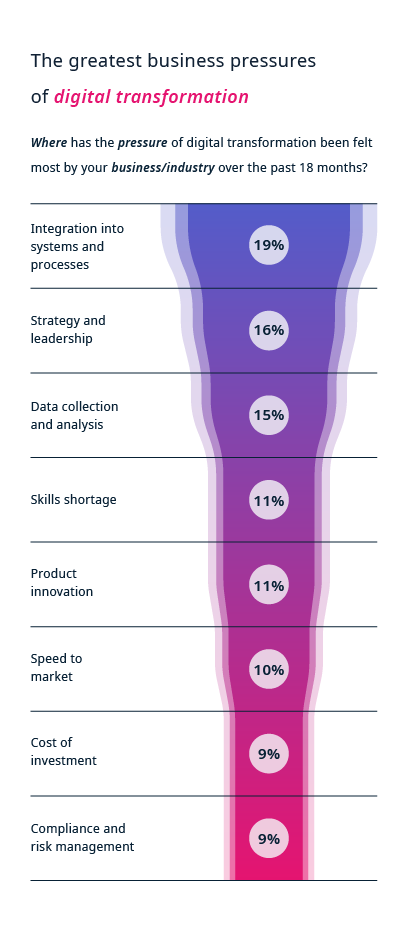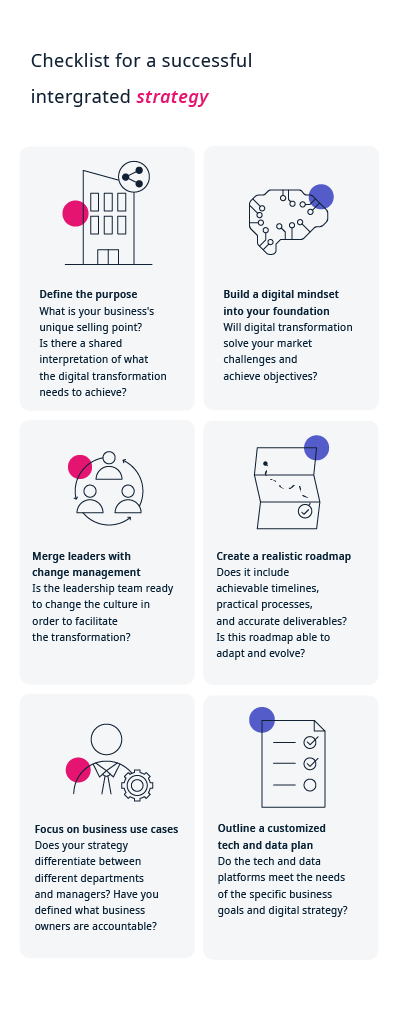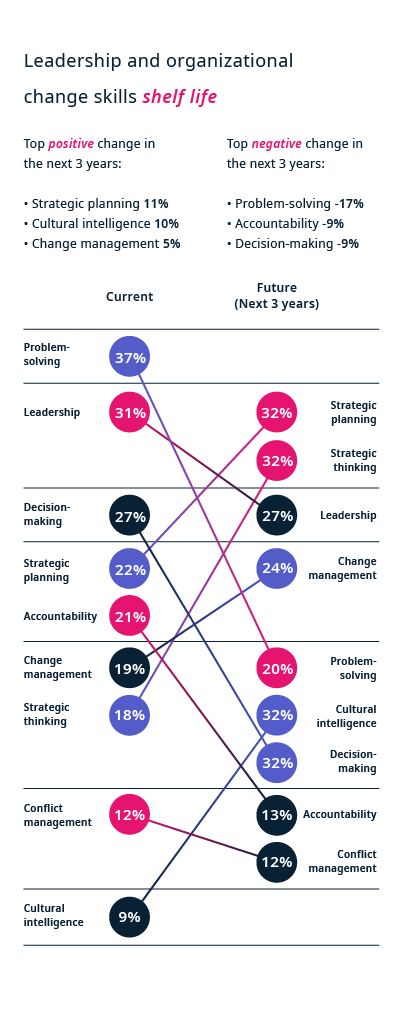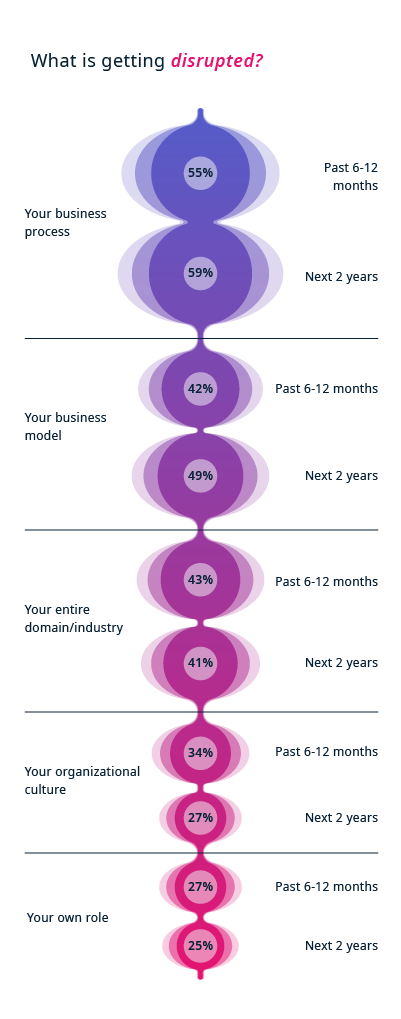5 Key Elements of a Successful Digital Transformation Framework
The world has turned up the digital dial in recent years. We’re plugging in more frequently and for longer, and it has revolutionized how we work, shop, and spend our downtime. Nine out of 10 people have increased their online activities,1 and these growing digital habits have spotlighted the most vital business adaptation required to future-proof success: digital transformation. Even during periods of decreased global economic activity, COVID-19 led to surges in e-commerce and accelerated digital transformation.2 Many digitized their activities 20 to 25 times faster during the pandemic, while others moved 43 times more quickly in integrating remote working than their executives thought possible.3
To understand these demands, GetSmarter recently surveyed 5,808 professionals from 128 countries. This revealed several crucial findings, starting with how digital transformation is perceived differently across all industries and job roles. It’s not solely focused on integrating and leveraging the latest technologies, such as machine learning (ML), artificial intelligence (AI), big data, and automation. It’s about unlocking innovation and resilience by igniting and empowering your human capital. Unfortunately, most companies don’t achieve this: 74% of transformation projects fail to achieve their full benefits due to their people not being equipped for change.4
By 2025, the global spend on digital transformation is forecast to reach $2.8 trillion,5 but up until now, only 35% of companies have reported to have met their transformation goals and earned a full return on investment.6 This successful minority were able to improve their employee experience, lower costs, and increase income from existing and new revenue streams.7
In order to truly benefit from digital transformation, a strategic digital framework is needed.
This framework must include practical steps that are customized according to the industry and unique needs of the organization. By getting this right, businesses will be able to critically examine their ideas and better anticipate any future obstacles. The best part: the business and employees benefit from digital transformation.
Here are the five key elements needed to build a successful digital framework.
1. Define clear objectives
In order to create a bespoke framework, based on objectives and long-term strategy, you’ll need to define exactly what digital transformation means to your company and employees. GetSmarter’s research found that there is no shared understanding or universally accepted standard: it reveals 19 different interpretations. To add to this uncertainty, the research also reveals that digital transformation is regularly confused with digitization and digitalization, which are processes that fall within digital transformation.

These varying interpretations lead to different goals among the leaders and managers, causing inconsistencies in actions and outcomes. If the goals of the digital transformation are ambiguous or not communicated properly, the end result will be misalignment and a failure in stakeholders’ eyes. Also, if the organization lacks a culture of inclusive transformation or the employees are resistant to change, achieving buy-in for new processes will be challenging.8 The only way to solve this is to create one integrated, holistic digital transformation framework that leverages both technology and people.
Once the unique interpretation of digital transformation has been defined and applied to the business, the next step is to craft a long-term, industry-specific strategy with a digital mindset. This sense of clear purpose energizes and aligns the whole organization and inspires every employee to work together towards practical, achievable objectives.9
2. Create an integrated strategy
The importance of these first two steps can’t be understated: only 59% of businesses overcome all hurdles to create a truly integrated digital strategy. This is a clear vision backed by a set of strategic objectives and sustainable transformation goals.10
Success then relies on the practical application of this integrated strategy. Results from the GetSmarter research found that the greatest pressure organizations feel within the transformation process comes from integrating into systems and processes.

One of the mistakes that companies make is to focus on specific technologies to improve general operations instead of creating a holistic strategy with the intention of transforming their business entirely across all systems and processes.
Similarly, digital transformations often disappoint due to layering “shiny new object” technologies onto broken processes, and teams that are resistant to change. Leaders can improve business transformation results by developing integrated strategies that start with a goal-driven process and organizational design change management.11 This also includes all touch points in the customer journey. “Digital transformation is all about increasing customer-centricity through technology,” says Misiek Piskorski, professor of digital strategy, analytics, and innovation at the Institute for Management Development (IMD).12
Piskorski is the Program Director of the Developing Digital Transformation Strategies online program from IMD. Learn more about what end-to-end digital change entails here.
This is where the field of system integration (SI) is vital, as it’s the process of interconnecting all of a company’s IT systems, technologies, applications, and software so that they function as a single system. SI connects the entire business infrastructure, enabling interoperability between the different tools.13 It can boost the speed of information flow, reduce operational costs, improve productivity, offer consistent communication, save money, and even increase sales.14 The rise in digital transformation projects has caused the SI industry to grow much faster, and experts predict the market value will reach $530 billion in 2025, double the 2015 value.15
Once you have defined your vision, objectives, and roadmap, there are six checkpoints you can use to gauge a strategy’s effectiveness – they’ve shown to increase the odds of success from 30% to 60%:16

Navigate a successful digital transformation with an understanding of strategic development, application, and change management on this online short course from Yale School of Management Executive Education.
3. Inspire a change in culture through leadership
Digital leadership has never been more critical. Decision makers need to find new techniques for spearheading and supporting a workforce consisting of full-time employees, AI tools, freelancers, and remote workers all operating together. Leaders have to be creative and agile with their leadership style while finding ways that work best for an evolving workplace.17
The GetSmarter survey finds that the two most crucial ingredients for digital transformation success are strong leadership and effective change management. Collectively, they ensure that all the employees are inspired, motivated, and aligned to their business’s plan for digital transformation. Leadership is an area of significant scrutiny for such projects: our research reveals that strategy and leadership is the second-highest pressure area for respondents trying to implement transformation initiatives in the last 18 months.
One of the biggest lessons for leaders is understanding that digital transformation is not only about harnessing new technology but also about inspiring and motivating human change. From the professionals surveyed in the GetSmarter research, 35% believe digital transformation is a people-centric change and 32% think it’s a tech-driven change.
Digital success relies on overcoming human barriers to change. This includes motivating employees to reimagine the work methods that they’ve long relied on and showing them that technology can help their careers, not hinder them. George Westerman, a principal research scientist for workforce learning at MIT, explains why leadership and change management are so crucial:
“Digital transformation is less of a digital problem than it is a leadership problem.” 18
Learn more from Westerman in his role as the Faculty Director of the Internet of Things: Business Implications and Opportunities online short course from the MIT Sloan School of Management.
Solving these people-based challenges is the responsibility of leadership, and it requires an ability to drive change at scale. Leadership must be combined with talent in critical positions, as there is never one individual who possesses all the required knowledge and capability.
The GetSmarter research reveals that the skills expected to have the largest positive change in usefulness over the next three years are strategic planning, cultural intelligence, and change management. These areas emphasize that digital transformation is a shift in the organization’s culture rather than merely in technology, and that for any kind of transition to be successful, leaders need to have a strong transformation plan in place. However, leaders need to also understand the digital ecosystem and its possibilities. By grasping the intricacies of effective digital transformation, they can develop the confidence to make investments in digital transformation strategies and capabilities that will enable continuous performance.19

4. Embrace adaptability and agility
Results from our digital transformation research reveal that 66% of respondents have experienced a significant amount of disruption in the last six to 12 months. The pandemic-forced shifts of recent years have affected us individually and our workplaces in several ways, and the trend of changing work patterns and emerging technologies doesn’t look to slow down anytime soon. It’s also turned digital transformation from a nice-to-have, lofty goal to an operational necessity.

“Over the past year, no area has undergone more rapid transformation than the way we work,” says Satya Nadella, CEO of Microsoft. “We will need to define productivity much more broadly – inclusive of collaboration, learning, and well-being to drive career advancement for every worker, including frontline and knowledge workers, as well as for new graduates and those who are in the workforce today. All this needs to be done with flexibility in when, where, and how people work.”20 The GetSmarter research validates this as respondents highlighted that adaptability and agility are valuable interpersonal skills for the immediate and long-term future.
Learning agility is a component of this – employees can learn from experiences and apply their new knowledge to unique and challenging situations. Executives with high levels of learning agility are five times more likely to stay highly engaged, and companies with particularly agile individuals have 25% higher profit margins.21 The readiness to learn and change means new opportunities are embraced faster. “By becoming digital, it introduces new revenue streams as old revenue streams deteriorate,” says Jeanne Ross, principal research scientist at the MIT Center for Information Systems Research.22
Agile learners can also unlearn unproductive habits and think outside of the box. It’s a skill that all employees need, especially if you’re in leadership. Research shows that the ability to make fast, agile leadership decisions remains the number one driver of digital transformations.23
Follow these four fundamental principles to adopt an agile mindset:24
- Prioritize people and interactions over processes and tools. This includes engaging with peers and thought leaders.
- Prioritize creating software that works over producing comprehensive documentation, which can cause unnecessary delays.
- Collaborate with customers instead of focusing on contracts and numbers, and let them inform product development and marketing.
- Respond to change, versus simply following a plan, with continuous adaptation. This entails a continual process of optimization, adjustment, and openness to change.
An agile mindset helps with dealing with rapidly changing conditions as part of a business and career growth as an individual. It offers a competitive advantage, especially in disruptive times.
5. Invest in upskilling
As our research has shown, the success of a digital transformation relies heavily on the use of innovative technologies and agile, empowered employees with the right skills. Change is occurring so quickly that existing skills are degrading, and new skills are required by all employees – not just IT specialists and leadership figures. Research from our survey corroborates this, as 58% of the GetSmarter respondents expect they’ll need to learn new skills for their current job within the next six months.
58% of the GetSmarter respondents expect they’ll need to learn new skills for their current job within the next six months.
The lesson here: excellence in this time will not come from a set-it-and-forget-it approach. Growth and innovation rely on a foundation of regular upskilling in both hard and soft skills.
The GetSmarter Digital Transformation Framework
Based on the insights we received from the GetSmarter survey, we’ve built an interactive roadmap for the digital skills you’ll need in the future. Leaders and employees of all levels can use this to address their skill gaps. Click on the different categories to see a detailed breakdown of the specific skills that are expected to be the most relevant in the next three years.
Our research highlighted that the key soft skills needed for the future are:
- Adaptability/agility
- Critical thinking
- Emotional intelligence
- Strategic planning
- Leadership
- Change management
The key hard skills required are:
- Advanced analytics
- Business intelligence
- Data management/data governance
- AI/ML
- Cybersecurity
- AR/MR/VR
A successful digital transformation framework is founded on these five steps: defining clear objectives, crafting an integrated strategy, leadership that drives change, adaptability, and upskilling. It has to be supported and driven by all employees, and it must be an iterative process. The framework should be tailored to the industry, the business objectives, and, crucially, the unique needs of every employee. The reward for business owners and leaders: a return of investment on a digital transformation project; and a skilled, agile workforce who can help future-proof your businesses success.
Learn how to transform both your business and your career digitally with GetSmarter’s latest research.
Start your digital transformation journey today
- 1 Vidal, Z. et al. (Apr, 2021). ‘How has the pandemic’s impact influenced our digital habits?’. Retrieved from Ericsson.
- 2 (Mar, 2021). ‘How COVID-19 triggered the digital and e-commerce turning point’. Retrieved from UN Conference on Trade and Development.
- 3 (Mar, 2021). ‘Will productivity and growth return after the COVID‑19 crisis?’. Retrieved from McKinsey.
- 4 (Nd). ‘Organizational change management and transformation’. Retrieved from Deloitte. Accessed April 29, 2022.
- 5 (Nov, 2021). ‘New IDC spending guide shows continued growth for digital transformation as organizations focus on strategic priorities’. Retrieved from IDC.
- 6 Forth, P. et al. (Dec, 2021). ‘Performance and innovation are the rewards of digital transformation’. Retrieved from BCG.
- 7 Dhasarathy, A. et al. (Mar, 2021). ‘Seven lessons on how technology transformations can deliver value’. Retrieved from McKinsey Digital.
- 8 (Jun, 2021). ‘13 Industry experts share reasons companies fail at digital transformation’. Retrieved from Forbes.
- 9 Forth, P. et al. (Dec, 2021). ‘Performance and innovation are the rewards of digital transformation’. Retrieved from BCG.
- 10 Forth, P. et al. (Dec, 2021). ‘Performance and innovation are the rewards of digital transformation’. Retrieved from BCG.
- 11 (Jun, 2021). ‘13 Industry experts share reasons companies fail at digital transformation’. Retrieved from Forbes.
- 12 (Oct, 2021). ‘IMD Developing Digital Transformation Strategies online program’. Retrieved from GetSmarter.
- 13 (Nd). ‘What is system integration and why do you need it?’. Retrieved from Bismart. Accessed April 29, 2022.
- 14 McKenna, N. (Sep, 2021). ‘Why is systems integration important?’. Retrieved from McKenna Consultants.
- 15 (Nd). ‘What is system integration and why do you need it?’. Retrieved from Bismart. Accessed April 29, 2022.
- 16 Forth, P. et al. (Oct 2020). ‘Flipping the odds of digital transformation success.’ Retrieved from BCG.
- 17 Katanic, S. (Jul, 2021). ‘Effective digital leadership is key to digital transformation’. Retrieved from Forbes.
- 18 Stackpole, B. (Aug, 2021). ‘Digital transformation after the pandemic’. Retrieved from MIT Open Learning.
- 19 (Nd). ‘Digital Transformation Strategy’. Retrieved from GetSmarter. Accessed April 29, 2022.
- 20 (Mar, 2021). ‘The next great disruption is hybrid work – are we ready?’. Retrieved from Microsoft.
- 21 (June, 2021). ‘The importance of learning agility in the workplace’. Retrieved from WeLearn.
- 22 (Jan, 2020). ‘MIT Sloan Organizational Design for Digital Transformation online short course’. Retrieved from GetSmarter.
- 23 Anderson, J. and Polasek, L. (Jul, 2021). ‘Four winning patterns of digital transformation’. Retrieved from Bain & Company.
- 24 (Apr, 2022). ‘FAQ: What are the 4 agile values? (plus principles)’. Retrieved from indeed.
